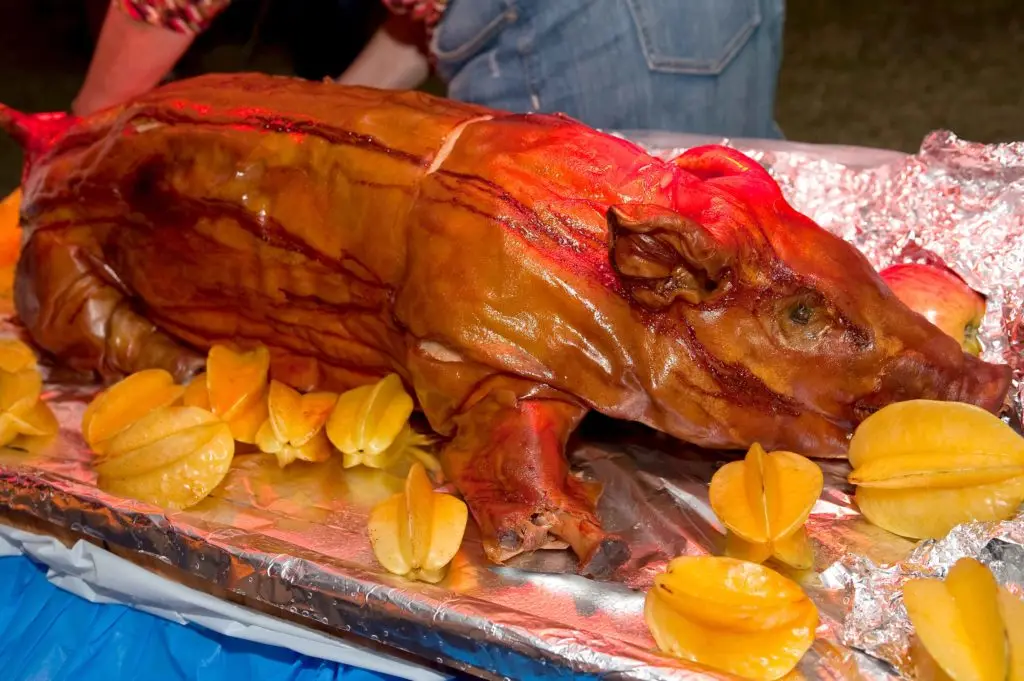Hotnon Babui: Roasted Pig

Table of Contents
Share This
Description
A whole pig slowly spit-roasted over a fire. Basting yields crispy skin and moist meat.
History
Origin
The Spanish brought pigs to the Mariana Islands, along with other introduced food items, shortly after colonization in the 17th century.
Catholic missionaries wrote that CHamorus lived off the land and the sea. Spanish missionaries and their administration brought pigs and cattle to the islands. When CHamorus were forced to live in established villages and had their traditional seafaring practices (such as off-shore fishing) banned to prevent their escape, they had to become accustomed to eating the imported meat.
Evolution
By the time Americans arrived on Guam at the beginning of the 20th century, it was common for families to have pigs (which are not as big and stocky as hogs) as part of their livestock. Pigs were raised for self-sustenance for families, but were also roasted for wedding parties and other special occasions such as fiestas. Like cattle, pigs were also used as dowry for a bride. The bigger the pig given, the prouder the family was of their offering.
The Spanish word for a roasted suckling pig is lechon, the same word used in the CHamoru and Filipino languages. Contemporary references are also “hotnon babui” (hotno is the CHamoru word for the Spanish oven) or “babui ni’ ma hotno”. Meat roasted on a spit is referred to as “i ma-bira na tininon babui.”
There are two types of pigs found on Guam: the wild pig (babuen hålomtåno’) and the domestic pig (babui), which is more common on the fiesta table. The image of the fierce-looking babuen hålomtåno’, with its coarse black hair and protruding tusks, is sometimes used as a scare tactic for young children during the Catholic religious observance of Lent to encourage them to behave well. The belief that has been passed down through the generations of some families is that the babuen kuresma (Lenten boar) will bite or harm children for infractions committed during the 40-day solemn observance of Lent.
Preparation
Preparing a pig for fiesta is a family and community affair. Men are responsible for slaughtering and cleaning the pig to prepare it for roasting. The pig is shaved, it’s blood drained and entrails removed. The entrails are used for fritåda, a blood stew, usually prepared by women.
Once the blood is drained, the whole pig is placed on a spit and put over an open fire for roasting. The skin is continuously basted so it turns crispy. Many people enjoy the crispiness and this – along with the flavor and moistness of meat – can demonstrate the skill of the cooks. A crank is used to turn the pig to ensure that the meat is evenly cooked. It takes about four hours to roast a 100-pound pig.
CHamorus have also used an ancient cooking method called chinahan (derived from the word “chahan”) to cook vegetables, fish or a pig. This method of underground cooking is common in Pacific cultures and is similar to how Hawai’ian Kalua pig is prepared. It involves digging a pit in the ground, lining it with lava stones and wood, building a fire, waiting for the fire to cool before placing food wrapped in breadfruit and banana leaves on the hot stones. The wrapped food is covered with more leaves and left to cook.
Chahan was originally used in the preparation of seafood and starches such as yams, but when pork (and beef) were introduced to the CHamoru diet it was cooked with the same method.
When the roasting is completed, the pig is placed on a serving tray that is decorated with sometimes elaborate dressings of fruit. Other times an apple is simply placed in its mouth.
Roasting a pig is a time-consuming event, so some families may opt for the convenience of buying a roasted pig from a bakery.
Placement on table
In large fiesta parties, the roasted pig is a central element on the table and a testament to the grandeur of the host family or village. It may be placed on a separate table along with other impressive (and expensive) meat selections such as beef steamboat roast, turkey and ham.
Recipe
I ma-bira na Tininon Babui: Spit-roasted Pig
100 pound pig, cleaned
Water
Place pig on a spit, turn using a brush to constantly baste with water. Cooking time is generally 4 hours. Fina’denne’ or another condiment of choice can add flavor to the meat after it is cooked.
